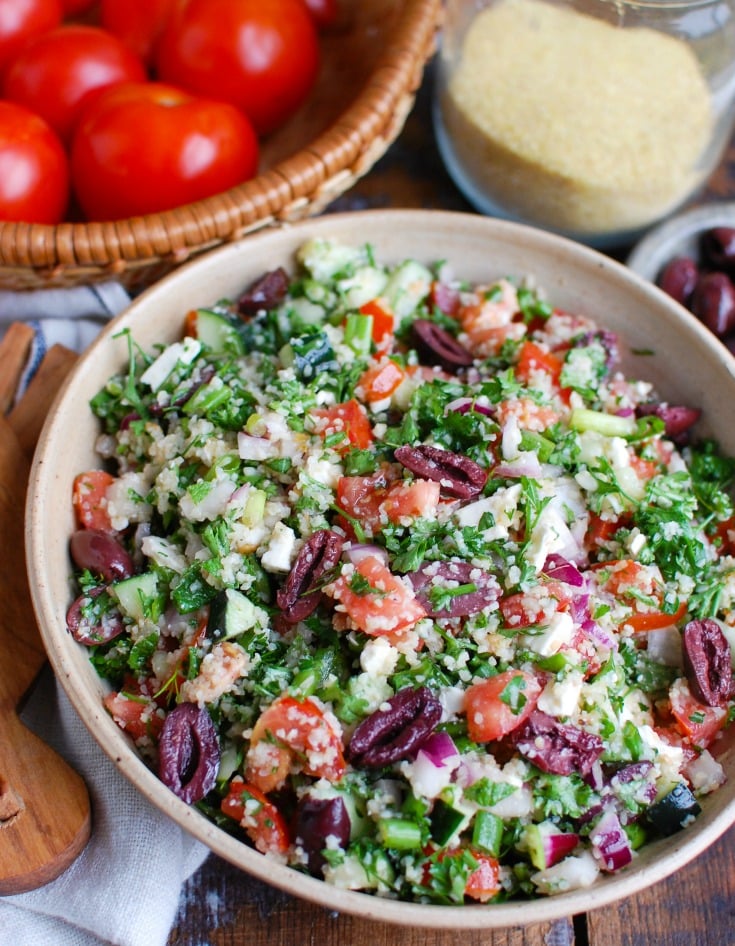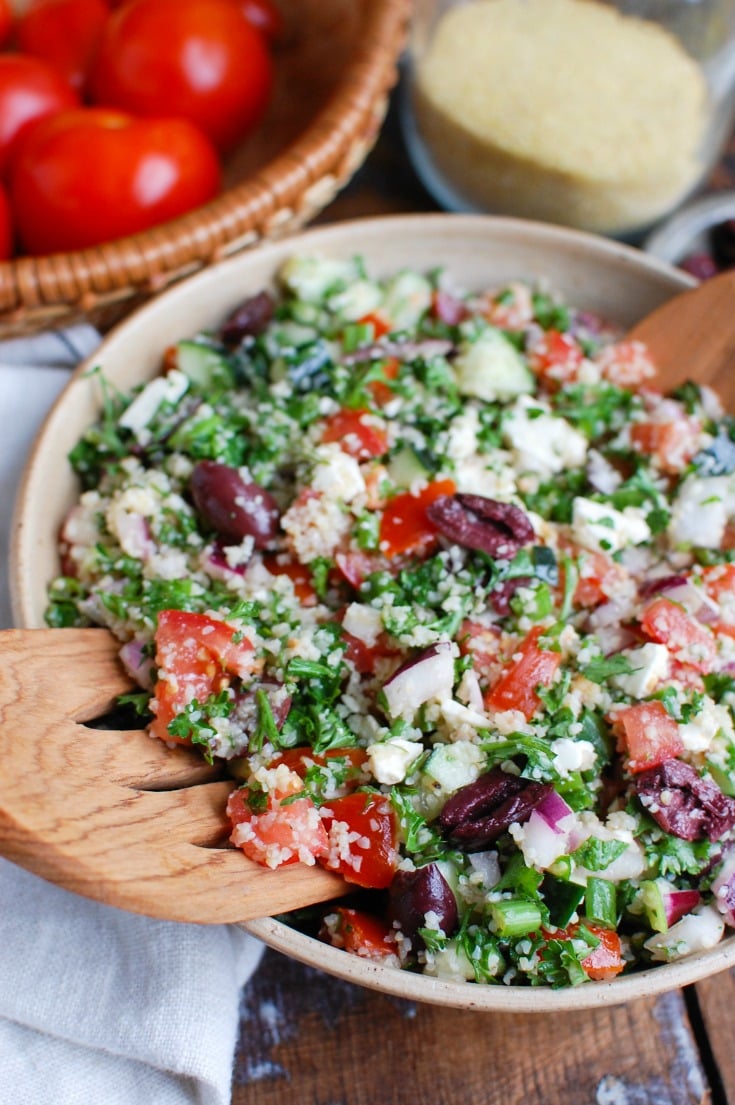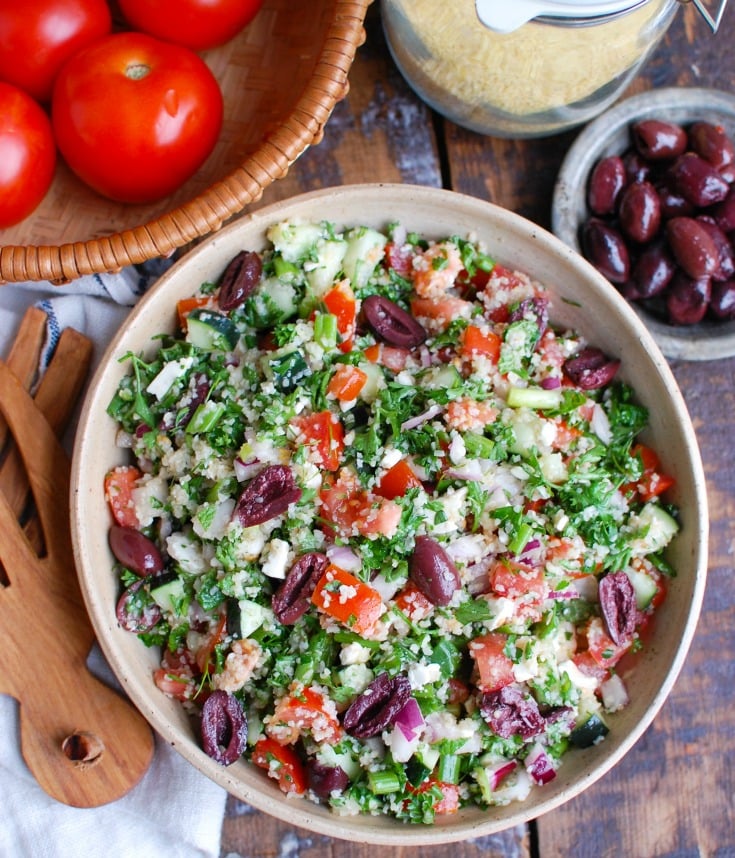Fresh & Flavorful Greek Tabbouleh Salad: An Easy Mediterranean Recipe
Dive into the vibrant flavors of the Mediterranean with this delightful Greek Tabbouleh. While rooted in the classic Lebanese tabbouleh tradition, this recipe introduces a refreshing Greek twist, incorporating beloved ingredients like briny Kalamata olives, creamy feta cheese, crisp red onion, and cool cucumber. These are perfectly complemented by the foundational elements of traditional tabbouleh: juicy tomatoes, fresh parsley, zesty green onions, and fragrant mint. The entire salad is brought together with a light, zesty lemon dressing, making it an ideal choice for a healthy, satisfying, and incredibly flavorful meal.

Do you find yourself drawn to the fresh, wholesome appeal of Greek-inspired dishes? If so, then prepare for a culinary treat! This Greek Tabbouleh recipe takes everything you love about the vibrant flavors of the Mediterranean diet and wraps it into one incredible salad. It combines the refreshing lightness of classic tabbouleh with the distinctive salty, tangy, and savory notes of Greek cuisine.
Today’s featured Greek Tabbouleh masterfully blends the essential components of traditional tabbouleh—like ripe tomatoes, copious amounts of fresh parsley, zesty green onions, and aromatic mint—with characteristic Greek ingredients. The addition of briny Kalamata olives, sharp red onion, cooling cucumber, and crumbled feta cheese elevates this simple bulgur salad into an unforgettable side dish or a light main course. All these fresh ingredients are then coated in a bright, lemony dressing that ties every flavor together beautifully.
Throughout the warmer months, I find myself preparing a batch of my Easy Tabbouleh Recipe almost every week. There’s something truly special about utilizing fresh garden vegetables or the bountiful produce found at local farmers’ markets to create such a wholesome and delicious meal. However, the changing seasons don’t deter me from enjoying one of my all-time favorite salads. Tabbouleh is a versatile dish that I enjoy making year-round, and I’m always eager to explore new and exciting variations.
In my culinary journey, I’ve previously shared recipes for Kale Cucumber Tabbouleh and a fantastic grain-free Cauliflower Tabbouleh, both offering wonderful twists on the classic. For those who might be new to preparing tabbouleh, let’s take a moment to discuss the fundamentals of crafting this perfect, healthy salad. Mastering the basics will ensure your Greek Tabbouleh is nothing short of spectacular.
Essential Ingredients for Your Greek Tabbouleh

You’ll quickly fall in love with this remarkably easy recipe and the fresh, simple ingredients it calls for. Each component plays a vital role in creating a harmonious and unforgettable flavor profile. This is truly one of my favorite go-to recipes for a light and healthy meal!
- Bulgur Wheat: The cornerstone of traditional tabbouleh, bulgur wheat provides a fantastic chewy texture and absorbs all the wonderful flavors of the dressing and vegetables. For the best results, especially in tabbouleh, you’ll want to soak the bulgur in cold water. This rehydrates it and softens it perfectly, making it ready to mix into your salad without cooking.
- Fresh Vegetables: This tabbouleh is bursting with a colorful mix of fresh vegetables. We use finely chopped red onion for a subtle bite, ripe tomatoes for sweetness and juiciness, crisp cucumber for a refreshing crunch, and pungent green onions for an extra layer of flavor. Feel free to adjust these to your preference or what you have on hand – though the combination here is truly perfect.
- Kalamata Olives: A hallmark of Greek cuisine, Kalamata olives add a wonderful briny, salty depth that perfectly complements the fresh vegetables and herbs. Ensure they are pitted and halved (or roughly chopped) for easy eating. If olives aren’t your favorite, you can certainly omit them, but they truly enhance the “Greek” aspect of this dish.
- Feta Cheese: Creamy, tangy, and salty feta cheese is a glorious addition to this salad. Its distinct flavor provides a beautiful contrast to the other ingredients and gives the salad that authentic Greek touch. I highly recommend using freshly crumbled feta from a block for the best texture and flavor, rather than pre-crumbled varieties.
- Abundant Fresh Herbs: A generous medley of fresh herbs is non-negotiable for a truly authentic and flavorful tabbouleh. In this Greek version, we combine vibrant mint, aromatic parsley, and fresh dill. These herbs don’t just garnish; they are central to the salad’s fresh taste. While dried herbs can be used in a pinch, fresh herbs will always elevate the flavor to another level.
- Light Lemony Dressing: The dressing is simple yet powerful, tying all the ingredients together with its bright and zesty profile. It’s a classic combination of high-quality extra virgin olive oil, a touch of red wine vinegar for tang, and plenty of fresh lemon juice. This light dressing ensures the salad remains refreshing and never heavy.

Creative Ways to Customize Your Greek Tabbouleh Salad:
This Greek Tabbouleh recipe is incredibly versatile, making it easy to adapt to your personal taste, what you have on hand, or to introduce new textures and flavors. Here are some fantastic ways to modify this already delicious salad:
- Additional Vegetables: Feel free to load up this salad with even more fresh produce. I particularly enjoy adding finely diced bell peppers (red, yellow, or orange for extra color and sweetness), crisp radish slices for a peppery kick, crunchy celery, savory sun-dried tomatoes (chopped), or shredded carrots for added texture and nutrients.
- Extra Herbs: Fresh herbs are what truly make this type of salad sing! While mint, parsley, and dill are standard, don’t hesitate to experiment with others. Try incorporating fresh cilantro for an earthy note, oregano for a more pronounced Greek flavor, or basil for a sweet and peppery aroma. Each herb adds a unique dimension.
- Legumes for Heartiness: To make this salad more substantial and protein-rich, beans are an excellent addition. My favorites include chickpeas (garbanzo beans) for a nutty flavor and satisfying chew, or white beans (like cannellini or great northern beans) for a creamier texture. They integrate beautifully and make the salad a complete meal.
- Cheese Alternatives: While feta cheese is my top choice for its authentic Greek flavor, other cheeses can also work wonderfully. Crumbled goat cheese offers a tangier and slightly creamier alternative, while small cubes of fresh mozzarella cheese would provide a milder, softer contrast.
- Crunchy Nuts and Seeds: Adding nuts and seeds is a fantastic way to introduce a delightful crunch and extra nutrients to your tabbouleh. Consider toasting sesame seeds, sunflower seeds, or slivered almonds for a deeper flavor. Pine nuts are a classic Mediterranean choice, and chopped walnuts or cashews can also provide a rich, buttery texture.
- Boost Your Protein: Transform this side dish into a complete and satisfying main meal by adding a source of protein. Excellent options include grilled shrimp, shredded rotisserie chicken, freshly grilled chicken breast, flakes of canned tuna or salmon, or even grilled steak. For a vegetarian or vegan option, firm tofu (marinated and pan-fried or baked) works surprisingly well.
- Leafy Greens: While tabbouleh is primarily a grain and herb salad, incorporating leafy greens can add volume and further nutritional benefits. Spinach is a mild choice that blends in seamlessly, but I also love the peppery bite and vibrant color that fresh arugula brings to this salad.

Storage & Preparation Tips for Your Greek Tabbouleh
Preparing this Greek Tabbouleh is straightforward, and with a few tips, you can ensure it’s as fresh and flavorful as possible, even when made ahead of time. The beauty of tabbouleh is that its flavors often meld and deepen over time, making it an excellent meal prep option.
Once prepared, Greek Tabbouleh keeps exceptionally well in a covered dish in the refrigerator for 3-4 days. For optimal freshness and to prevent it from becoming soggy, I recommend draining any excess liquid that might accumulate at the bottom of the bowl before serving. You can also freshen it up just before serving by adding a little extra drizzle of high-quality extra virgin olive oil and a squeeze of fresh lemon juice. This revitalizes the flavors and moisture content, making it taste as if it was just made.
For best results when making ahead, you can prepare the bulgur wheat and chop all the vegetables and herbs separately. Store them in airtight containers in the refrigerator. Mix everything together with the dressing about an hour before you plan to serve. This allows the flavors to meld beautifully without the vegetables becoming too soft or the herbs losing their vibrant color.
Frequently Asked Questions About Greek Tabbouleh
I highly recommend using extra-fine bulgur wheat for tabbouleh. Its delicate texture softens quickly with just soaking (no cooking required), resulting in that classic light and fluffy consistency characteristic of authentic tabbouleh. If you only have medium or coarse bulgur, that’s perfectly fine, but you will need to soak it in hot water for a longer period, typically about an hour, to ensure it softens adequately before mixing it into your salad.
Tabbouleh is delicious served either cold or at room temperature. Both methods work wonderfully and offer slightly different experiences. I grew up eating tabbouleh served at room temperature, which allows the flavors to be more pronounced and vibrant. However, on a hot day, a chilled tabbouleh can be incredibly refreshing. The choice ultimately comes down to personal preference and the climate.
Yes, fine chopping is key to achieving the desired texture and presentation of tabbouleh. Finely chopping the parsley and other vegetables helps them integrate seamlessly, ensuring every bite is a harmonious blend of flavors and textures. This method also helps the parsley maintain a light, fluffy consistency rather than clumping together. While it might take a little more time, using a sharp knife to finely chop everything will prevent bruising the delicate herbs and vegetables, resulting in a fresher and more appealing salad. Avoid over-chopping to the point where ingredients become mushy.
Absolutely! While traditional tabbouleh uses bulgur wheat, which contains gluten, you can easily make a delicious gluten-free version. Simply substitute the bulgur wheat with cooked quinoa, cauliflower rice (finely chopped raw cauliflower), or even cooked sorghum. These alternatives mimic the texture of bulgur quite well and are excellent for those with gluten sensitivities or preferences.
Greek Tabbouleh is incredibly versatile! It makes a fantastic side dish for grilled meats like chicken souvlaki, lamb kofta, or fish. It’s also perfect as part of a Mediterranean mezze platter alongside hummus, tzatziki, pita bread, and dolmades. For a light lunch, enjoy it on its own or add some grilled halloumi cheese. It’s also a great addition to a picnic spread or a potluck, as it travels well and tastes even better as the flavors meld.
Tried this recipe? Leave a star rating and comment below! Subscribe to my newsletter or follow me on
Facebook,
Instagram, or
Pinterest for the latest.
Greek Tabbouleh

Pin
Ingredients
- 1/2 cup bulgur wheat, extra fine
- 1/3 cup red onion, chopped
- 5-6 Roma Tomatoes, diced
- 2 cups parsley, finely chopped
- 1/2 English cucumber, diced
- 6-7 green onions, green and white parts chopped
- 3/4 cup Kalamata olives, pitted, halved
- 3 ounces feta cheese, crumbled
- 1/4 cup mint, finely chopped
- 2 Tablespoons dill, chopped
- 1/4 cup extra virgin olive oil
- 2 Tablespoons red wine vinegar
- 1/4 cup lemon juice
- Salt and pepper to taste
Instructions
-
Begin by preparing the bulgur wheat. Place the extra fine bulgur wheat in a small bowl. Rinse it thoroughly under cold water, gently squeezing the wheat in your hand to remove excess starch and any impurities. Transfer the rinsed bulgur to a new, clean dish. Repeat this rinsing process two more times to ensure the bulgur is clean and ready to absorb moisture.
-
After the final rinse, cover the cracked wheat (bulgur) with cold water, ensuring it’s fully submerged. Let it soak and refrigerate for at least one hour. This soaking process allows the bulgur to soften and become tender without needing to be cooked, giving it that characteristic tabbouleh texture.
-
While the bulgur is soaking, prepare your fresh vegetables and herbs. In a large mixing bowl, combine the finely chopped red onion, diced Roma tomatoes, an ample amount of finely chopped fresh parsley, diced English cucumber, and the chopped green and white parts of the green onions. Add the halved Kalamata olives, crumbled feta cheese, and the finely chopped fresh dill and mint. Ensure all ingredients are chopped to a similar, small size for an even distribution of flavors and textures.
-
Prepare the zesty lemon dressing. In a mason jar or a salad dressing container, combine the extra virgin olive oil, red wine vinegar, fresh lemon juice, and season with salt and pepper to taste. Secure the lid tightly and shake vigorously until all the ingredients are well mixed and emulsified.
-
Once the bulgur has finished soaking, drain any remaining water thoroughly. Add the softened bulgur wheat to the bowl with the chopped vegetables and herbs. Gently toss all the ingredients together to ensure an even mix.
-
Pour the prepared dressing over the tabbouleh mixture. Toss gently again until all the vegetables, herbs, and bulgur are thoroughly coated with the delicious lemon dressing. For best flavor, refrigerate the finished tabbouleh for at least 30 minutes to allow the flavors to meld. If you’re short on time, you can serve it immediately, but a short chill time enhances the overall taste experience.
Notes
- For a gluten-free option or a different texture, tabbouleh also works great with other grains including quinoa (cooked and cooled) and sorghum (cooked and cooled).
- Boost the protein content by adding other grilled chicken, baked salmon, or plant-based options like chickpeas or white beans.
Nutrition
Nutrition information is automatically calculated, so should only be used as an approximation.
Why You’ll Love This Healthy Greek Tabbouleh
This Greek Tabbouleh isn’t just another salad; it’s a celebration of fresh, wholesome ingredients and vibrant flavors. Here’s why it deserves a spot in your recipe rotation:
- Incredibly Fresh and Light: Packed with an abundance of fresh herbs and crisp vegetables, this salad is wonderfully refreshing, especially on warm days.
- Bursting with Flavor: The combination of tangy feta, briny Kalamata olives, zesty lemon dressing, and aromatic herbs creates a complex and satisfying taste experience.
- Nutrient-Dense: Tabbouleh is naturally rich in vitamins, minerals, and fiber from the bulgur and fresh produce, making it an excellent choice for a healthy diet. It fits perfectly into a Mediterranean lifestyle.
- Easy to Make: With simple steps and no cooking required for the bulgur, this salad comes together quickly, making it ideal for busy weeknights or last-minute gatherings.
- Versatile: As discussed, it’s highly customizable with various vegetables, proteins, and grains, allowing you to tailor it to your dietary needs and preferences.
- Perfect for Meal Prep: Its flavors develop beautifully over time, making it a great option to prepare in advance for lunches or quick sides throughout the week.
Bringing the Mediterranean to Your Table
Greek Tabbouleh is more than just a recipe; it’s an invitation to explore the rich and wholesome culinary traditions of the Mediterranean. With its vibrant colors, refreshing flavors, and healthy ingredients, it embodies the essence of simple, delicious eating. Whether you’re serving it as a light lunch, a side dish for a family meal, or a vibrant addition to your next potluck, this salad is sure to impress.
So gather your freshest ingredients, embrace the joy of healthy eating, and whip up a batch of this fantastic Greek Tabbouleh. It’s an easy, flavorful, and incredibly satisfying way to nourish your body and delight your taste buds. Enjoy every refreshing bite!
